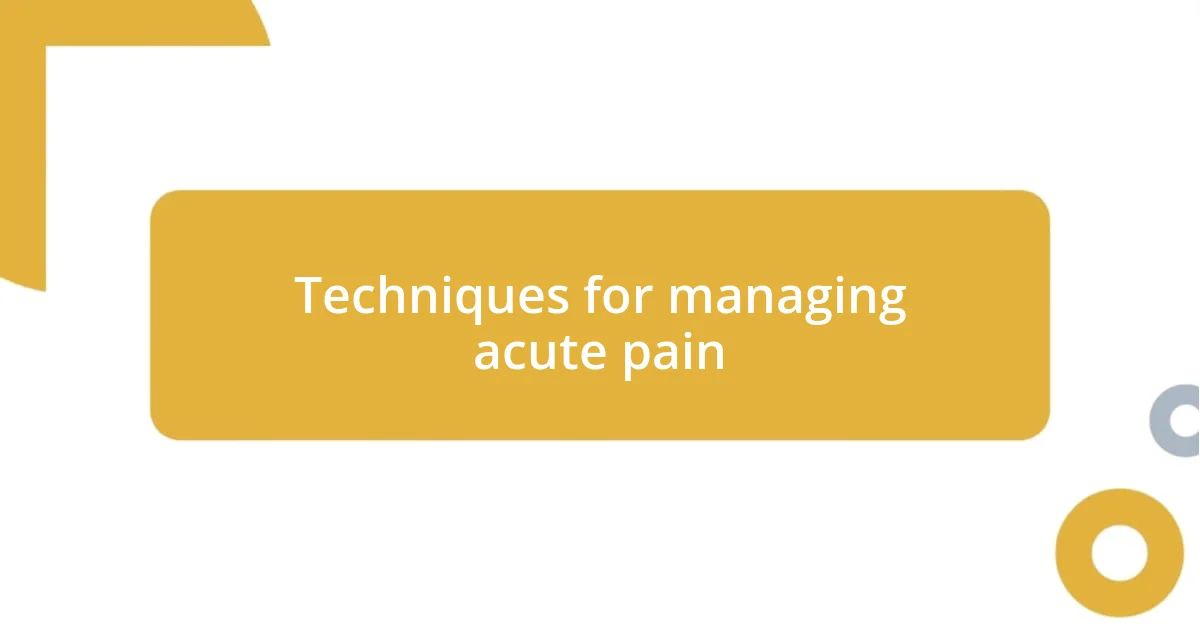Key takeaways:
- Pain management is holistic, combining physical, emotional, and psychological approaches for effective relief.
- Immediate techniques for acute pain include cold/heat therapy, over-the-counter medications, and mindfulness exercises.
- Lifestyle changes, such as physical therapy, a pain journal, and dietary adjustments, significantly impact chronic pain management.

Understanding pain management principles
Understanding pain management principles starts with recognizing that pain is not just a physical sensation; it’s a complex interplay of emotional and psychological factors. I remember a time when I thought I could simply push through discomfort. But I quickly learned that ignoring the emotional toll of pain only intensified my experience. Have you ever felt that same overwhelming sense of frustration when trying to cope with pain?
In my experience, effective pain management relies on a multi-faceted approach. For example, I found that combining medication with relaxation techniques like meditation significantly improved my pain levels. This combination not only addresses the physical aspects of pain but also nurtures mental well-being. Doesn’t it make sense to treat the whole person rather than just the symptoms?
I also discovered that communication plays a vital role in pain management. When I was open with my healthcare provider about my pain levels and emotional state, we could collaboratively develop a treatment plan that truly made a difference. Have you considered how sharing your pain journey might empower you to take control of your own healing? It’s a step that can lead to better outcomes and a greater sense of agency.

Techniques for managing acute pain
Managing acute pain requires immediate and effective techniques that can significantly improve one’s quality of life. One time, after a sports injury, I was surprised by how helpful immediate interventions were. Ice packs worked wonders in reducing swelling and numbing the pain, while gentle stretching and movement helped keep my body engaged without overdoing it.
Here are some techniques I found particularly useful:
- Cold therapy: Applying an ice pack can decrease inflammation and numb sharp pain.
- Heat therapy: Using a warm compress helps relax tight muscles and improve blood flow.
- Over-the-counter medications: Nonsteroidal anti-inflammatory drugs (NSAIDs) like ibuprofen can provide quick relief.
- Mindfulness and breathing exercises: Focusing on my breath during intense pain moments helped me regain control and reduce anxiety.
- Physical activity: Engaging in light movement, like walking, eased tension and promoted comfort.
I honestly believe these strategies helped to alleviate my acute pain and create a pathway toward recovery.

Strategies for chronic pain relief
When it comes to chronic pain relief, I’ve learned that a blend of lifestyle adjustments and therapeutic techniques can make a significant difference. For instance, I started integrating physical therapy into my routine. I was skeptical at first, but after just a few sessions, I felt my strength returning and the constant ache began to fade. I wonder if you’ve ever felt that hope as you work through the discomfort—it’s empowering!
Another strategy I found beneficial is keeping a pain journal. At one point, I committed to writing down my pain levels and triggers daily, and it was revealing. This practice not only helped me identify patterns but also facilitated deeper conversations with my healthcare team. Have you considered keeping track of your journey? It could uncover insights you never expected.
Nutrition and hydration have also proven invaluable in managing chronic pain. I couldn’t believe that simple dietary changes, such as increasing my intake of anti-inflammatory foods like berries and leafy greens, could lead to tangible relief. I remember feeling lighter and more energetic, which in turn diminished my pain perception. So, have you thought about how what you eat influences your pain levels?
| Strategy | Description |
|---|---|
| Physical Therapy | Guided exercises to improve mobility and reduce pain. |
| Pain Journal | Tracking pain levels and triggers for better management. |
| Nutrition | Incorporating anti-inflammatory foods for overall relief. |

Importance of lifestyle changes
Lifestyle changes play a crucial role in managing pain effectively. I’ve personally discovered that small, consistent modifications can yield significant results. For example, when I started a daily yoga practice, not only did my flexibility improve, but my chronic back pain also lessened considerably. Isn’t it fascinating how something as simple as stretching can reshape how we feel?
Moreover, I learned how essential sleep is for pain management. There was a time when my sleep routine was practically non-existent, and I paid the price with heightened discomfort. After prioritizing my rest—creating a calming bedtime ritual and minimizing screen time before bed—my overall pain experience transformed. Can you imagine how a good night’s sleep could influence your pain levels?
Dietary shifts have been another game-changer in my journey. Adding omega-3 rich foods, like salmon and walnuts, has become a staple in my diet. I’ll never forget the day I realized my body felt lighter after making these changes. It’s incredible how what we put into our bodies can directly affect our pain experiences. Have you considered what might happen if you altered your eating habits?















